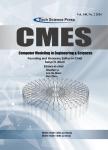Glass Fibre Reinforced Concrete Rebound Optimization
作者机构:KaramanogluMehmetBey UniversityFaculty of EngineeringCivil Engineering DepartmentKaraman/T URKEY Celal Bayar UniversityFaculty of EngineeringCivil Engineering DepartmentManisa/TURKEY Kastamonu UniversityKastamonu Vocational SchoolKastamonu/TURKEY
出 版 物:《Computer Modeling in Engineering & Sciences》 (工程与科学中的计算机建模(英文))
年 卷 期:2017年第113卷第2期
页 面:203-218页
核心收录:
学科分类:08[工学] 0805[工学-材料科学与工程(可授工学、理学学位)] 0835[工学-软件工程] 0811[工学-控制科学与工程] 0701[理学-数学] 0812[工学-计算机科学与技术(可授工学、理学学位)]
主 题:Glass fibre glass fibre reinforced concrete finite elements method spray distance spray Angle
摘 要:Glass fibre reinforced concrete placement technique generates losses due to rebound effects of the already sprayed concrete particles.Rebounded concrete amount cause a significant difference between the initial mix design and emplaced mix compositions.Apart from the structural differences,it comes with a cost increase which was resulted by the splashed concrete amount.Many factors such as viscosity and quantity of mixes dominate this rebound amount in sprayed glass fibre reinforced concrete applications depending on production technologies and processes;however,this research focuses on the spray distance and the angle of the spray gun which mainly effects the rebound amount in glass fibre reinforced concrete production.This paper aims to understand the required angle and distance for glass fibre reinforced concrete mixes having on-site plastic viscosity values.Glass fibre reinforced mixtures were also modelled with a finite element method based software and,the analysis results were compared with production line results.Results of the analysis and on-site studies showed a decisive correlation between,discharge distance,discharge angle and the viscosity of the concrete.



